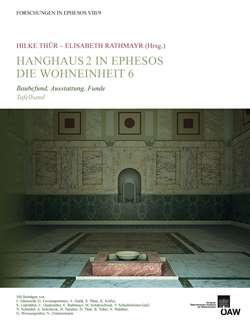Hilke THÜR
war wissenschaftliche Mitarbeiterin am Institut für Kulturgeschichte der Antike an der ÖAW bis 2007
Elisabeth RATHMAYR
ist wissenschaftliche Mitarbeiterin am Institut für Kulturgeschichte der Antike an der ÖAW
|
 |
ISBN 978-3-7001-7355-7 Print Edition
ISBN 978-3-7001-7654-1 Online Edition
Forschungen in Ephesos 8/9
2014,
2 Textbände mit 866 Seiten,Tafelband mit 443 Tafeln und CD-ROM, 39x30cm, broschiert
€
310,00
Die sieben Wohneinheiten des Hanghauses 2 im Bautypus von großen Peristylhäusern bilden seit der Überdachung mit einem
Schutzbau und der Öffnung für Besucher eine der touristischen Hauptattraktionen des Ruinengeländes von Ephesos.
Der privilegierte Status der Bewohner der hier vorgelegten Wohneinheit 6 wird bereits durch die zentrale Lage und den
direkten Eingang vom embolos (Kuretenstraße) angezeigt. Glücklicherweise ist ihr Eigentümer Gaius Flavius Furius Aptus
durch Inschriften bekannt. Er ist als Bauherr für den großzügigen Ausbau des Hauses in den Bauphasen II (120 n. Chr.)
und III (ca. 150 n. Chr.) mit geräumigen, mit Marmor luxuriös ausgestatteten Fest- und Bankettsälen verantwortlich.
Er bekleidete nicht nur hohe städtische Ämter, sondern war auch Priester des Dionysos Oreios Bakchios pro poleos.
Als Priester und Vorstand stellte er sein palastartiges Stadthaus als Versammlungsort für diesen Dionysosverein zur
Verfügung, wofür neben vielen anderen Hinweisen vor allem das Fehlen von privat genutzten Räumen spricht.
Jedoch wird durch Türverbindungen zu den benachbarten Wohneinheiten 4 und 7, in denen diese Raumfunktionen vorhanden
waren, angezeigt, dass die Wohneinheit 6 zusammen mit diesen Wohneinheiten im Besitz der Familie des
Gaius Flavius Furius Aptus stand.
Dem Konzept der Publikation der Hanghäuser in Ephesos folgend, werden in dem reich illustrierten Band, dem auch
eine CD mit Visualisierungen und Plänen beigegeben ist, der Baubefund mit den Bauphasen, der Architektur und den
Wasserinstallationen, die Ausstattung mit den Marmorwand- und -bodenverkleidungen, der Wandmalerei, den Stuckdekorationen
und den Mosaiken ebenso wie die Funde mit den Skulpturen, der Keramik, den Kleinfunden, dem Glas und den Münzen sowie
den archäozoologischen Funden vorgelegt; darüber hinaus werden auch die Graffiti vorgestellt, die einen unmittelbaren
Einblick ins Alltagsleben gewähren und sich in großer Zahl auf den Wandmalereien befinden. Ein weiterer Abschnitt
behandelt die Restaurierungen der Marmorvertäfelungen im Marmorsaal 31. Darüber hinaus ergab die kontextuelle Analyse
der in der Wohneinheit 6 durchgeführten Grabungen zusammen mit den daraus stammenden Funden, dass auf dem Areal dieses
Hauses bereits in späthellenistischer Zeit ein Hofhaus an der Kuretenstraße vorhanden war.
Gedruckt mit Unterstützung des Fonds zur Förderung der wissenschaftlichen Forschung (FWF).

…
Since the erection of the new protective roof of Terrace House 2 and its opening to tourists shortly afterwards, it has
been one of the main attractions of antique Ephesos. Terrace House 2 is a big insula housing seven dwelling units built
in the type of peristyle houses. The privileged status of the owners of Dwelling Unit 6 can already be hinted at the
central location of the house and its entrance directly from Curetes Street, a main thoroughfare and processional way
of the city. Fortunately, the home owner of Dwelling Unit 6, Gaius Flavius Furius Aptus, is known by inscriptions.
He was responsible for the generous rebuilding of Dwelling Unit 6 in the building periods II (120 AD)
and III (mid 2nd century AD), including big and lavishly decorated halls, which were used for banquets and
celebrations (Marble Hall 31, Apsidal Hall 8). Gaius Flavius Furius Aptus not only held municipal offices, but was
also priest of Dionysos Oreios Bakchios pro poleos. In this capacity, he opened his house for meetings of the Dionysos
association, over which he presided. This is mainly indicated by the absence of private rooms in the house; albeit
connecting doors between Dwelling Unit 6 and Dwelling Units 4 and 7 give evidence that these three houses belonged to
the family of Gaius Flavius Furius Aptus.
Following the publication concept of the Ephesian Terrace Houses, the publication of Dwelling Unit 6 provides a detailed
description of the architecture, the reconstruction of the building periods, the water supply and drainage, the marble
décor of the walls and floors, the wall paintings, stucco work, mosaics, sculpture, small finds, ceramic, glass and coin
finds as well as the analysis of the archaeozoological remains; moreover, the numerous graffiti on the wall paintings
giving a direct insight into everyday life are discussed as well as the extensive restoration work of Marble Hall 31,
which has been undertaken in recent years. The publication also includes an analysis of the pre-use of the area, whereby
as a new result a peristyle house can be assumed already in late Hellenistic times. The volume also provides a CD,
containing visualisations of certain rooms as well as building and floor plans.
|




 Home
Home
 Print
Print
 References
References
 Share
Share
